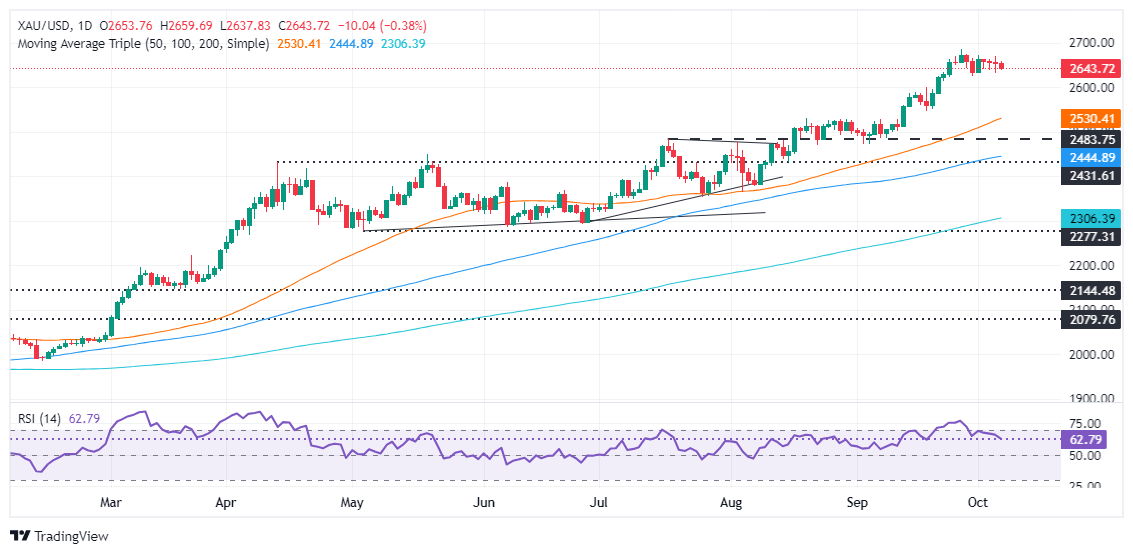- Gold trades at $2,645, down 0.30%, as US 10-year Treasury yields rise to 4.026%, capping further upside.
- Middle East conflict escalation involving Israel, Hamas, and other groups like Houthis supports Gold amid risk-off sentiment.
- Market expectations of a 25 bps Fed rate cut remain high at 83.5%, while a 50 bps cut is off the table for now.
Gold price edges down during Monday’s North American session, yet it remains within the $2,630 – $2,659 range as US Treasury bond yields capped the yellow metal advance, while the escalation of the Middle East conflict keeps the precious metal from falling further. The XAU/USD trades at $2,645, losses 0.30%.
Market mood has deteriorated due to the war in the Middle East. The exchange of fire prolonged as Israel continued its ground operations in Lebanon, while Hamas launched rockets at Tel-Aviv. Ceasefire hopes faded as the conflict broadened, involving other groups like Houthis attacking ships in the Red Sea.
In the meantime, the latest US stellar Nonfarm Payrolls report in September sparked a jump in US Treasury bond yields.
Traders disregarded a 50 basis point (bps) cut by the Federal Reserve (Fed), according to CME FedWatch Tool data. The odds for a 25 bps Fed rate cut are 83.5%. Meanwhile, the chances of lowering rates by 50 bps are 0%, but they increased to 16.5% for a hold.
The US 10-year Treasury yield jumps over five and a half basis points to 4.026% as traders seem confident the Fed will lower borrowing costs by 25 bps in each of the last two policy meetings in 2024.
In the meantime, the Greenback clings to minimal gains as the US Dollar Index (DXY), which tracks the buck’s value against a basket of six currencies, is at 102.52, virtually unchanged but at levels last seen in August 2024.
Next week, the US docket will feature the release of inflation data, the Fed’s last Meeting Minutes, jobless claims, and the University of Michigan Consumer Sentiment.
Daily digest market movers: Gold price falls amid fading US recession fears
- Following the last US jobs report, recession fears faded. Therefore, most Wall Street banks like Citi, JP Morgan, and Bank of America revised its November Fed call from a 50 to 25 bps rate cut.
- Minneapolis Fed President Neel Kashkari said he doesn’t see signs of “resurgent inflation” and is confident that inflation is returning to 2%.
- Meanwhile, the People’s Bank of China (PBoC) halted its Bullion purchases for the fifth month. China’s reserves were unchanged, as their holdings stood at 72.8 million troy ounces at the end of last month.
XAU/USD technical analysis: Gold price slips as sellers eye support underneath $2,650
Gold price remains capped within a trading range, while the Relative Strength Index (RSI) suggests that a leg down is underway despite printing bullish readings. Still, the slope is accelerating downwards, closing toward the neutral line.
If XAU/USD drops below the September 30 low of $2,624, that could sponsor a leg down toward the $2,600 mark. On further weakness, the following floor will be the 50-day Simple Moving Average (SMA) at $2,531.
On the other hand, if Gold prints a daily close above $2,650, the XAU/USD needs to clear $2,670 to challenge the year-to-date high of $2,685. Up next will be the $2,700 mark.
Risk sentiment FAQs
In the world of financial jargon the two widely used terms “risk-on” and “risk off” refer to the level of risk that investors are willing to stomach during the period referenced. In a “risk-on” market, investors are optimistic about the future and more willing to buy risky assets. In a “risk-off” market investors start to ‘play it safe’ because they are worried about the future, and therefore buy less risky assets that are more certain of bringing a return, even if it is relatively modest.
Typically, during periods of “risk-on”, stock markets will rise, most commodities – except Gold – will also gain in value, since they benefit from a positive growth outlook. The currencies of nations that are heavy commodity exporters strengthen because of increased demand, and Cryptocurrencies rise. In a “risk-off” market, Bonds go up – especially major government Bonds – Gold shines, and safe-haven currencies such as the Japanese Yen, Swiss Franc and US Dollar all benefit.
The Australian Dollar (AUD), the Canadian Dollar (CAD), the New Zealand Dollar (NZD) and minor FX like the Ruble (RUB) and the South African Rand (ZAR), all tend to rise in markets that are “risk-on”. This is because the economies of these currencies are heavily reliant on commodity exports for growth, and commodities tend to rise in price during risk-on periods. This is because investors foresee greater demand for raw materials in the future due to heightened economic activity.
The major currencies that tend to rise during periods of “risk-off” are the US Dollar (USD), the Japanese Yen (JPY) and the Swiss Franc (CHF). The US Dollar, because it is the world’s reserve currency, and because in times of crisis investors buy US government debt, which is seen as safe because the largest economy in the world is unlikely to default. The Yen, from increased demand for Japanese government bonds, because a high proportion are held by domestic investors who are unlikely to dump them – even in a crisis. The Swiss Franc, because strict Swiss banking laws offer investors enhanced capital protection.




